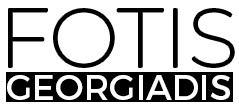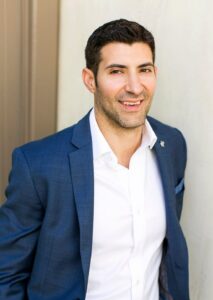An Interview With Fotis Georgiadis
Bring real value and tell the story. The great thing about having more options than could have been fathomed ten or so years ago is that it’s harder to survive unless your product or service provides real value. These days, the brands that thrive after launch are passionate about their customers’ successes and do a great job of letting those customers tell the story with user-generated content and testimonials.
As part of our series about how to create a trusted, believable, and beloved brand, I had the pleasure to interview Julia Weikel
Born in Australia, Julia Weikel is a branding and marketing domain industry insider with years of education and marketing experience in Australia, China, and the U.S. Julia attended fashion school and studied marketing in Melbourne.
Thank you so much for doing this with us! Can you tell us a story about what brought you to this specific career path?
I moved to China in 2011, three days after marrying my American husband. While living in Shanghai, I ran and promoted venues and events for a fast-growing hospitality and entertainment group. This experience involved partnering with global brands and keeping their venues full and top of mind for resident expats and western tourists. This was before Instagram was broadly adopted, and Facebook is blocked in China, so it’s an understatement to say we had to be creative.
After moving to the U.S., I led a boutique digital marketing agency providing branding and reputation management marketing services primarily in the legal, real estate, and insurance industries. Differentiating and providing a platform for individuals in these markets posed a challenge that required my team’s creativity and hustle. This experience taught me how earned media works and how to appeal to journalists and editors with narratives that also helped our clients get established in their local markets and ultimately secure more sales leads.
In subsequent years, go-to-market strategies became my specialty, building customer acquisition and retention nurture sequences for a mobile app and a cannabis education and logistics platform. For the last few years at Donuts Inc., I have leveraged my professional experience and passion for visual identity and branding along with my acute understanding of small business challenges to help them in branding and marketing descriptive domains, meaning domain names featuring keywords on the right of the dot in place of the legacy options of .com, net, etcetera.
Can you share a story about the funniest marketing mistake you made when you were first starting? Can you tell us what lesson you learned from that?
This is a perfect ice-breaker question because I have a doozy that is always top of mind when I need to reassure someone who may have had a faux pas. While representing a PR and reputation management services agency, handling a situation with a high-priority client, signing off and thanking the client in a very formal email, I addressed the gentleman named Bob as Boob.
I noticed after he responded to my message — being gracious enough to ignore the slip. I took a screenshot I shared with new team members to ease their anxiety in facing clients for the first time. I think it’s important to break down illusions or expectations of perfection.
What do you think makes your company stand out? Can you share a story?
Donuts owns and operates the world’s largest inventory of keyword descriptive domains with extensions like .live, .world, .studio, and over 250 more TLDs (top-level domains). What sets us apart is the breadth of our inventory both in its size and application, in addition to the opportunity for brands to establish unique and meaningful digital identities that break the status quo in all the right ways.
Observing organic adoption of our descriptive domains by the best brand builders and startups is rewarding. Creators who understand the value of an authentic, uncompromised digital identity see the opportunity and no-brainer decision to select a domain that does away with legacy extensions that were standard for previous generations. Instead, they opt for modern, anti-status quo domains that better represent them. A few examples include
Our descriptive domain names also stand out because they include premium features essential in protecting a founder’s business and the safety of their customers’ data.
Are you working on any exciting new projects now? How do you think that will help people?
Anything we do that spreads awareness of new domain options is exciting. We’re lucky to be working with solutions that, once exposed to prospective users, are a “no brainer.” I’m very mission-driven and enthusiastic about helping people discover better solutions for their brands — and our product delivers.
Ok let’s now jump to the core part of our interview. In a nutshell, how would you define the difference between brand marketing (branding) and product marketing (advertising)? Can you explain?
When contemplating brand marketing, I consider what our offerings represent for people. The right domain names will enable them to tell their stories with an authentic digital identity that facilitates building a connection with their customers. Product marketing tends to be more about product positioning and messaging, while brand marketing emphasizes the brand’s identity and is designed to elicit an emotional response.
Can you explain to our readers why it is important to invest resources and energy into building a brand, in addition to the general marketing and advertising efforts?
For better or worse, a brand is judged on its ability to communicate its value and positioning in the marketplace through its visual identity, UX, and its tapestry of brand touchpoints across various mediums. We’re inundated with content and advertisements all day. Consumers are more than your prospects. They’re professionals who judge brands and products through their own lenses, which, while unique, are accustomed to brand executions like Nike and Apple. A brand that doesn’t pay attention to detail, is inconsistent, and compromises on the small things will either be disregarded as a legitimate option or stand out in all the wrong ways.
Can you share 5 strategies that a company should be doing to build a trusted and believable brand? Please tell us a story or example for each.
- Bring real value and tell the story. The great thing about having more options than could have been fathomed ten or so years ago is that it’s harder to survive unless your product or service provides real value. These days, the brands that thrive after launch are passionate about their customers’ successes and do a great job of letting those customers tell the story with user-generated content and testimonials.
- Go beyond two-dimensional. I’m so inspired by the volume of DTC (direct to consumer) brands who are constructing exciting three-dimensional worlds around something as simple as, say, a single cosmetic product. When people make a purchase decision, they add to their personal brand or identity. From the trendy olive oil and adaptogenic peanut butter, to their toothbrush mentioned by their favorite podcasters, to the apps on their phone and clothing, individuals are making purchase decisions that reflect their aspirational identity.
Going beyond two-dimensional can be a differentiating factor that makes or breaks a brand. The worlds that some standout brands have created beyond their tangible product attributes can lead to unmatched brand loyalty in addition to user-generated content as your advocates share their enthusiasm.
A top-of-mind example is starface.world. Visitors to their website and social accounts are immersed in the bright and colorful “world” of Starface. The brand is so much more than blemish patches. It has proven to be a dynamite strategy with healthy funding rounds and the launch of a new waterless personal care brand cleanwith.plus. - Have your founders and leadership team come out from the shadows. Share your story and communicate your values by focusing on the human side of your organization. A recent example is the building in public of the beverage brand drink.haus. The founders shared their product and brand development journey, including wins and hardships. Feeling like you know the people and mission behind a company can establish brand trust, which is potentially one of the biggest hurdles for new companies breaking into a niche market.
On the flip side, the court of public opinion can quickly decimate a brand if there are reports of unsavory leadership behavior or unethical practices. I believe this a good thing and can be leveraged positively for budding founders breaking into the market.
4. Don’t lose sight of internal brand alignment and messaging as you grow. Most companies’ brands and messaging evolve with their product offerings and core competencies. As a brand scales and brings on new teams and agency partners, it’s important to foster an internal culture that reflects the values and brand positioning that is projected externally.
5. Go all the way. In episode 386 of How I Built This with Guy Raz, he shares an anecdote of wandering through the grocery store and picking up some frozen plant-based nuggets, “I don’t even like plant-based nuggets, but the brand leaped out at me! A really good design or branding suggests that the people behind the product have thought very intentionally about what it is they want to convey to you, the person who passes by thousands of items at the grocery store.”
Additionally, Andrea Hernández of Snaxshot recently highlighted that studies have shown that “beauty” literally triggers a part of our cerebellum that controls our hand movement, making us want to reach out for beautiful things and that 52% of consumers have changed product brands because of new packaging design.
New brands working within the confines of outdated branding status-quos in an attempt to capture a large segment of a market are at risk of diluting their branding and messaging. Branding that boldly represents who you are and what you’re about is always the better strategy, and I predict we will continue to see more of it.
In advertising, one generally measures success by the number of sales. How does one measure the success of a brand building campaign? Is it similar, is it different?
Quantitative user research can gauge brand or product awareness and show impact of awareness campaigns over time. It’s crucial to use category and brand awareness leveraging this type of research when working with a product or service that doesn’t fit a traditional buyer’s journey. If every marketing campaign had to show directly attributable ROI, billboard advertising would cease to exist.
What role does social media play in your branding efforts?
Social media is the place where your branding is tested. Prospective and existing customers can and will share their honest opinions on everything your product or service promises.
A Meltwater study concluded that the main reasons people share things on social media are to:
Better the lives of others (94%)
Reflect their online identity (68%)
Grow and nourish relationships (80%)
Have others comment on it and engage (81%)
Keeping this in mind can help create content that effectively engages your audience in the right way.
What advice would you give to other marketers or business leaders to thrive and avoid burnout?
WFH turned out to be one of the best things for my personal productivity but can also blur the line between work and personal life. It’s essential to understand boundaries are important and advocate for work/life boundaries. This allows team members to maintain high performance.
You are a person of great influence. If you could inspire a movement that would bring the most amount of good to the most amount of people, what would that be? You never know what your idea can trigger. 🙂
I want to see continued evolution and fracturing of consumer product brand conformity. The early 2000s reflected a strong cultural position of “mainstream, premium brand versus the other,” illustrated clearly with CPG (consumer packaged goods) and FMCG (fast-moving consumer goods) markets. Within a category, there were mainstream brands or generic branded “off brands.” Today’s generic and alternative brands do not carry this stigma of subpar quality and compromise.
Consumer brands are establishing themselves within niche markets and sustaining rapid growth and cult followings. While this is a use case in the consumer goods category, it can be applied to digital brands in the same way. I’m sure legacy brand strategists see this market shift and continue to get on board.
We are blessed that very prominent leaders in business and entertainment read this column. Is there a person in the world with whom you would like to have lunch or breakfast with? He or she might just see this, especially if we tag them. 🙂
I’d pay good money and sign any number of NDAs to sit in on a brainstorming session with the MSCHF(a Brooklyn-based art and advertising collective) team. They’re tapped into another level of creativity that I don’t think exists anywhere else.
How can our readers follow you on social media?
https://twitter.com/julia_weikel
https://www.linkedin.com/in/juliaweikel/
Thank you so much for joining us. This was very inspirational.
Julia Weikel Of Donuts: Five Things You Need To Build A Trusted And Beloved Brand was originally published in Authority Magazine on Medium, where people are continuing the conversation by highlighting and responding to this story.



